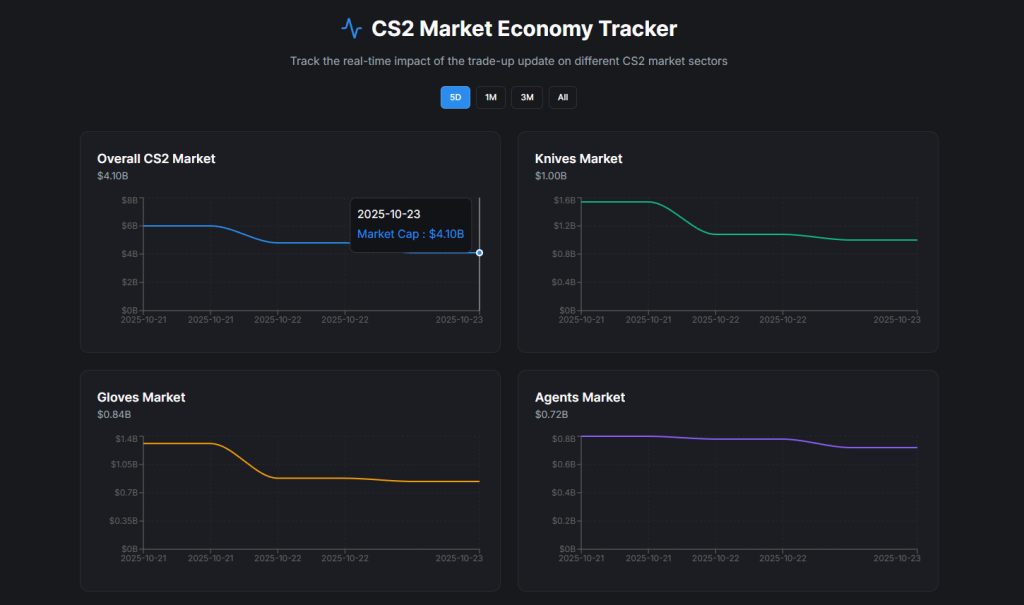Bodrum Escapes: Your Guide to Luxury and Leisure
Explore the best of Bodrum with exclusive insights and tips for an unforgettable experience.
When Pixels Lose Their Shine: Understanding the CS2 Skin Market Valuation Drop
Uncover the shocking truth behind CS2 skin market valuation drops and what it means for collectors. Don’t miss out on this essential insight!
The Impact of Game Updates on CS2 Skin Valuation: A Deep Dive
In the rapidly evolving world of CS2 skins, game updates play a crucial role in shaping their valuation. Every time developers roll out patches or significant updates, the in-game economy experiences fluctuations that can either elevate or diminish the worth of specific skins. For instance, when a skin is featured in promotional events or becomes part of limited-edition collections, its perceived value can skyrocket due to increased demand. Conversely, the introduction of new skins or balance changes may render existing ones less desirable, leading to a drop in market prices. This dynamic interplay underscores the importance of staying informed about game updates to make educated decisions regarding skin investments.
Moreover, community sentiment often shifts with each update, influencing skin valuation significantly. For example, a widely anticipated update that introduces new gameplay mechanics may boost interest in certain skin categories, such as those associated with popular weapon types. Players frequently share insights and analyses on forums and social media, creating a ripple effect that impacts demand. Therefore, understanding the community's reaction and the context behind each update is essential for players and investors alike. In this landscape, being proactive and following the latest news can mean the difference between a profitable skin collection and one that loses value over time.

Counter-Strike is a highly popular first-person shooter that has evolved over the years, with numerous iterations captivating players worldwide. The game's competitive nature has led to various discussions regarding its economy, including significant events like the market cap crash cs2, which impacted its player base and the in-game economy. With its blend of strategy, teamwork, and skill, Counter-Strike remains a staple in the esports community.
Why Are CS2 Skins Losing Value? An Analysis of Market Trends
The recent decline in the value of CS2 skins can be attributed to several market trends that are reshaping the landscape of virtual assets. First and foremost, fluctuations in supply and demand play a crucial role. As new skins are regularly introduced through limited-time events and updates, the abundance of available options can dilute the perceived value of existing skins. Additionally, the rise of community-driven marketplaces has increased competition, making it easier for players to buy and sell skins without relying on traditional platforms. This increased accessibility can lead to a downward pressure on prices as sellers try to offload skins quickly.
Another significant factor contributing to the depreciation of CS2 skins is the shifting interests of the player base. As new games and updates emerge, players often gravitate toward fresh content, which can lead to a decline in demand for older or less popular skins. Furthermore, the investment mentality among players can fluctuate, resulting in rapid sell-offs when trends change. In essence, CS2 skins losing value reflects a combination of market dynamics and player behavior, highlighting the need for investors to stay informed about current trends and community sentiment.
How to Navigate the Declining CS2 Skin Market: Tips for Collectors
The CS2 skin market has faced significant challenges in recent times, leading many collectors to reevaluate their strategies. To successfully navigate this declining market, it's essential to stay informed about the latest trends and shifts in player preferences. One effective approach is to participate in community forums and follow market analysis blogs, as they often provide real-time insights into price fluctuations and popular skin types.
Additionally, consider diversifying your collection by investing in skins that have historically held their value or have potential for future appreciation. This can involve looking for rare, limited-edition drops or focusing on skins that complement popular CS2 themes. Remember, patience is key in a declining market; holding onto well-chosen skins can yield better returns in the long run.